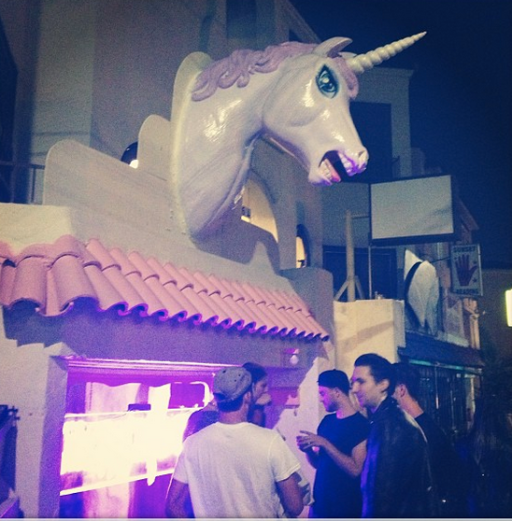
Christine Stormberg is a force to be reckoned with. Tina Gallery, her latest project and namesake, has no rules and no formality. Tucked behind a Wacky Wacko storefront, run by fellow artists Peggy Noland and Seth Bogart, the whole enterprise feels like its own exhibition, playfully questioning the hierarchy of galleries, commerce, and performance.
“I’m interested in how a shop can function as art.” Christine says.
In 1961, Claes Oldenburg shared a similar thought. He opened up The Store on 107 E. 2nd Street in NYC, a rented commercial space which doubled as his studio. There, he sold sculptures of familiar products one might find in a store: undergarments, a slice of pie, sundae, cash register, etc. The main rule was no item could be functional. They were all art objects. After about a year, The Store closed and Oldenburg used his space to host performances.

While Oldenburg examined how art spaces can exist as a whole other animal alongside low-brow commerce and high-end galleries, Wacky Wacko and Tina Gallery continue to challenge not only this idea of art and commerce, but how alternative spaces themselves fluidly identify or perform for us.
For a time, before Peggy and Seth cycled in, Christine ran the storefront alongside artist Anna Dewey Greer— an endeavor titled The Dog Show— which in hindsight, according to Christine, also feels performative.
“We just became these shop girls. That’s how people saw us. So, we played it up. We became like these characters.”
Performance is about representation. It’s also about efficiency and behavior. The best participants enter the craft willing to unlock something more guttural and vital about the self. In this sense, performance is associated with not only control, but maybe even more so: catharsis. A momentary surrendering for the sake of touching something deeper.

Likewise, The Dog Show was more than a shop. With a unicorn head literally trumpeting the exterior and a lavender cave sparkling the interior complete with flowing fountain, a creative release throbbed into the community with a proud feminine bend. Christine and Anna— working autonomously as artists, curators, and proprietors all in one physical place— explored flights of fancy. They moved from making bikinis to brewing conceptual potions such as “Ghost of Womanly Instinct” and bedazzling bongs. They even built a faux QVC style shopping channel for their creations.
.
“We always wanted it to be a space for girls. That’s important.”
Christine explains that galleries can sometimes feel stiff and male-centric. She and Anna wanted to make room for women’s voices to be heard while developing artistic friendships. So, in addition to showcasing their own work, they hosted events for other females— from visual artists to storytellers and beyond.
“I don’t really know what I’m doing until after I do it.” Tina says playfully.

I love that she states this with absolute enthusiasm and passion. I wonder how many other artists feel this way, but are shy to say so— Because of grad school. Because of the academy. Because of sales. Because of grants. Because of . . . who knows?
There is a Dionysian aspect to making. It’s important for us to acknowledge this. It’s why art’s exciting— adventurous. The heart is a factor. It feeds on feelings and sparks our hands without logic. Similarly, Christine’s heart is gutsy, open, and vulnerable in her work but maybe even more importantly— with her pals. This is what made the closing of Dog Show so difficult.
When the project ended, Anna moved back to Omaha, married, and continued to pursue other creative endeavors. Christine stayed. Luckily, friends Peggy and Seth jumped on board, taking over the storefront, allowing Christine time to percolate in her studio, which she built in the back of her former shop.

“I was very depressed.” Christine tells me.
Not sure of what to do next, she opted to save money by living in her studio and showering at the gym. It was a dark time. One night, a break-in occurred. There was only minor damage— thankfully, she was out of town— but, the feeling of invasion was haunting.
“When the cops arrived, they said— ‘You live here? Alone? You need to buy a gun.’”
At first, she was scared, opting to crash at friends’ houses instead of returning home, but soon that feeling shifted. The thought of altering her routine out of fear was infuriating. This revved her up into a world of workouts and drawing robust and tough muscle ladies. She loves how they are ugly and beautiful at the same time— but most importantly, strong.

Christine’s images of women confidently posing with borderline grotesque and luminous curves are pervasive— on her pink truck, on a mural outside the storefront, on flyers for her LA Kings shows, and of course in the back of Wacky Wacko— on display at Tina Gallery.

They resonate like a mantra: How females can perform as much as they can collectively conjure. In tandem with her Dog Show shop girl persona or Tina Gallery’s physical space, women not only can but should momentarily inhabit and shapeshift into whatever they want . . . for as long as they want. It’s a spiritual beckoning and awakening beyond the caldron and into the art world.
Oooooh! So cool! Thanks for sharing her story and these pics! xoxo
Thanks, Jean!!!! 🙂